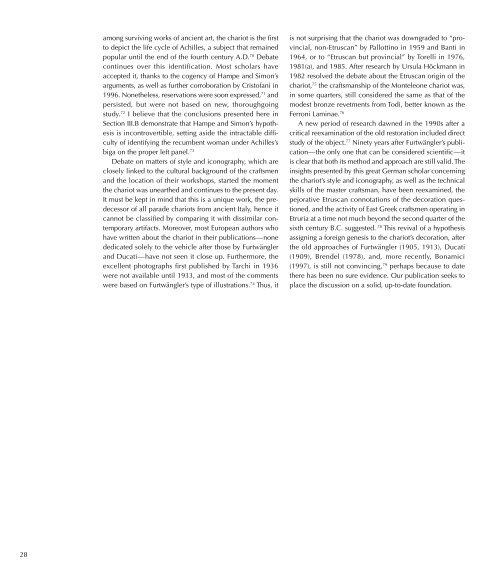Journal - Comune di Monteleone di Spoleto
Journal - Comune di Monteleone di Spoleto
Journal - Comune di Monteleone di Spoleto
You also want an ePaper? Increase the reach of your titles
YUMPU automatically turns print PDFs into web optimized ePapers that Google loves.
28<br />
among surviving works of ancient art, the chariot is the first<br />
to depict the life cycle of achilles, a subject that remained<br />
popular until the end of the fourth century a.d. 70 debate<br />
continues over this identification. most scholars have<br />
accepted it, thanks to the cogency of Hampe and Simon’s<br />
arguments, as well as further corroboration by Cristofani in<br />
1996. nonetheless, reservations were soon expressed, 71 and<br />
persisted, but were not based on new, thoroughgoing<br />
study. 72 i believe that the conclusions presented here in<br />
Section iii.B demonstrate that Hampe and Simon’s hypothesis<br />
is incontrovertible, setting aside the intractable <strong>di</strong>fficulty<br />
of identifying the recumbent woman under achilles’s<br />
biga on the proper left panel. 73<br />
debate on matters of style and iconography, which are<br />
closely linked to the cultural background of the craftsmen<br />
and the location of their workshops, started the moment<br />
the chariot was unearthed and continues to the present day.<br />
it must be kept in mind that this is a unique work, the predecessor<br />
of all parade chariots from ancient italy, hence it<br />
cannot be classified by comparing it with <strong>di</strong>ssimilar contemporary<br />
artifacts. moreover, most european authors who<br />
have written about the chariot in their publications — none<br />
de<strong>di</strong>cated solely to the vehicle after those by Furtwängler<br />
and ducati — have not seen it close up. Furthermore, the<br />
excellent photographs first published by Tarchi in 1936<br />
were not available until 1933, and most of the comments<br />
were based on Furtwängler’s type of illustrations. 74 Thus, it<br />
is not surprising that the chariot was downgraded to “provincial,<br />
non-etruscan” by Pallottino in 1959 and Banti in<br />
1964, or to “etruscan but provincial” by Torelli in 1976,<br />
1981(a), and 1985. after research by ursula Höckmann in<br />
1982 resolved the debate about the etruscan origin of the<br />
chariot, 75 the craftsmanship of the monteleone chariot was,<br />
in some quarters, still considered the same as that of the<br />
modest bronze revetments from To<strong>di</strong>, better known as the<br />
Ferroni laminae. 76<br />
a new period of research dawned in the 1990s after a<br />
critical reexamination of the old restoration included <strong>di</strong>rect<br />
study of the object. 77 ninety years after Furtwängler’s publication<br />
— the only one that can be considered scientific — it<br />
is clear that both its method and approach are still valid. The<br />
insights presented by this great German scholar concerning<br />
the chariot’s style and iconography, as well as the technical<br />
skills of the master craftsman, have been reexamined, the<br />
pejorative etruscan connotations of the decoration questioned,<br />
and the activity of east Greek craftsmen operating in<br />
etruria at a time not much beyond the second quarter of the<br />
sixth century B.C. suggested. 78 This revival of a hypothesis<br />
assigning a foreign genesis to the chariot’s decoration, after<br />
the old approaches of Furtwängler (1905, 1913), ducati<br />
(1909), Brendel (1978), and, more recently, Bonamici<br />
(1997), is still not convincing, 79 perhaps because to date<br />
there has been no sure evidence. our publication seeks to<br />
place the <strong>di</strong>scussion on a solid, up-to-date foundation.


